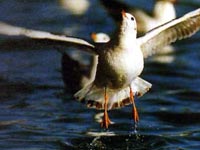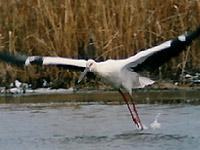
Set on the coast some 280 km east of Beijing, the seaside holiday resort of Beidaihe is famous not only as a tourist center and as a good place to recuperate after illness, but also as one of the best places in the world to see migratory birds.
China's Yanshan Mountain Range winds its way thousands of miles from the west to the eastern seaboard. It sends a number of waterways like the Henghe, Daihe, Yanghe and Luanhe rivers down to the Bohai Sea at Beidaihe. They create a vast area of wetlands, mud-banks, and lagoons with rich feeding and good places for birds to rest. Here migratory routes come together like great seasonal rivers of birds linking northeast Asia with south China, Indo-China, Australia and even far off east Africa.
Nature has richly endowed Beidaihe with bird species and of the 1,198 found in China, 416 have been recorded at Beidaihe. This is a part of the world that plays host to eighteen species of gulls, three of swans, and six of cranes.
Xu Weishu, vice director of the China Ornithological Society tells of the time when as many as 2,729 oriental white storks were recorded in Beidaihe, doubling the previous world record.
Look into the skies of Beidaihe in the first ten days of November every year and you will be sure to see flocks of red-crowned cranes and white cranes.
The year from May 1999 to May 2000 saw ten new bird species added to the list for Beidaihe.
Back in the 1940s Danish scientist, Axel Hemmingsen, published a report saying that he had seen large numbers of cranes at Beidaihe, but no one followed up on this at the time. Then in 1985 guided by Hemmingsen's report, British ornithologist Doctor Martin Williams first came to Beidaihe. With the help of an official from the Beidaihe tourism authority, Dr Williams visited Shijiutuo Island in nearby Laoting County. What he discovered there was far beyond his expectations and he found many new kinds of birds. Since then, accompanied by his Chinese counterpart, Xu Weishu, he has brought many overseas professionals together in Beidaihe every year to enjoy watching the birds and carry out research.

Since the first two parties of Chinese bird enthusiasts visited Beidaihe in 1999, more and more domestic visitors have joined bird watching groups going there on vacation.
Beidaihe has enjoyed a good reputation since 1893. It was then that a British engineer helping build a railway line recognized that with its low hills, beaches and sea breezes, the headland was an ideal place to go to escape the summer heat of the interior. On his recommendation, the first holidaymakers arrived. Beidaihe, until then a poor fishing village, quickly became popular with diplomats, merchants, missionaries, and well off Chinese.
Meanwhile the birds are regular visitors here too. Flocks of gulls are easily spotted. What might not be so easy is to be able to distinguish among the bewildering variety in the skies over Beidaihe. Many different birds pass through here as the seasons come and go and every year still sees fresh species spotted. It is a magnificent sight to see the occasional flock of large cranes pass by or to watch the birds of prey, however the larger birds have been decreasing in number.
Round the calendar
The period spanning the last ten days of April through the last ten days of May is the best season for bird watching. This is when you can see the greatest number and variety of birds in Beidaihe.
Then the period from the last ten days of August through September is the time for the medium and small wading birds to pass through.
October brings another peak season as many birds pass through the area, going south for the winter.
As the colder weather comes in with the first ten days of November, flocks of cranes will be making their way south. They will come north again the following March.
The best spots
· For waterfowl and songbirds, try Chitu Hill, Lianfeng Hill and the hilltops in Geziwo Park or the many well-wooded courtyards in Beidaihe District.
· For swimming and wading birds, Daihe, Yanghe and Dapu rivers should not disappoint.
· Visit Jiaoshan Mountain to enjoy watching birds of prey and songbirds.
· Shijiutuo Island in nearby Laoting County is well worth an extended visit of a few days duration.
During the course of a typical 12-day visit, you might expect to see 200 different kinds of birds. Beidaihe China International Travel Service arranges specialist tours for bird enthusiasts. Their office number is 086-335-4033598.
(China.org.cn by Wang Zhiyong, September 9, 2004)
|

